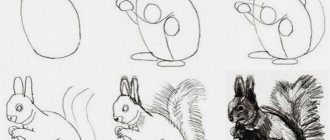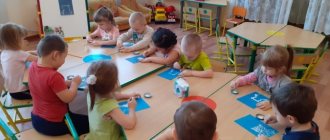Experiments with sand
Target:
1. Help children better understand the inanimate world around them;
2. Create favorable conditions for sensory perception, improving such vital mental processes as sensations, which are the first steps in understanding the world around us.
3. Through games and experiments, teach children to determine the physical properties of sand.
4. Teach children to make independent conclusions based on the results of the examination.
5. Nurture the moral and spiritual qualities of a child during his communication with nature.
Experiences and experiments with sand:
No. 1 “Where does sand come from”
Material: stones, sheets of white paper, magnifying glass.
Progress of the experiment:
Take 2 stones and knock them against each other, rub them over a sheet of paper.
- How do you think it's pouring in?
- Take your magnifying glasses and look at this.
- How did we get sand?
- How does sand appear in nature?
Conclusion: Wind and water destroy stones, as a result of which sand appears.
No. 2 “What is sand made of”
Materials: cups of sand, sheets of white paper, magnifying glasses.
Progress of the experiment:
Pour sand onto a piece of paper and examine it with a magnifying glass.
- What is sand made of? (grains – grains of sand)
- What do grains of sand look like?
- Are grains of sand similar to each other?
To get a large pile of sand you need a lot of sand.
Conclusion: Sand consists of small grains of sand that do not stick to each other.
No. 3 “Does sand fall easily?”
Material: trays with sand.
Progress of the experiment:
Offer to take a handful of sand into your fist and release it in a small stream.
- Does it crumble easily?
Conclusion: dry sand easily crumbles and crumbles into grains of sand.
No. 4 “Why is it inconvenient to play with sand in strong winds”
Material: “sandbox” - a jar filled with a thin layer of sand.
Progress of the experiment:
Examination of the prepared “sandbox”. We create a “hurricane” - we sharply squeeze the can with force.
- What's happening and why?
Conclusion: The grains of sand are small, light, do not stick to each other, they cannot hold on to each other or to the ground with a strong stream of air.
No. 5 “Where did the water disappear?”
Material: cups with sand and water.
Progress of the experiment:
Pour water into a glass with sand. Let's touch the sand.
- What has he become?
- Where did the water go?
Conclusion: water is quickly absorbed into the sand.
No. 6 “Sculpting from sand”
Material: trays with wet sand.
Progress of the experiment:
Let's try to make balls and sausages from wet sand. Leave until dry
- What happens to sand crafts after drying?
Conclusion: You can sculpt from wet sand, but after drying it crumbles.
No. 7 “Wet sand takes any desired shape”
Material: tray with wet sand, various molds.
Progress of the experiment:
Pour wet sand into molds and make figures.
- What kind of figures did you get?
- What kind of sand were you able to make the figures from?
Conclusion: Wet sand takes any shape.
No. 8 “Traces and prints remain on wet sand”
Material: trays with wet and dry sand.
Progress of the experiment:
Offer to leave handprints on dry sand.
- Are the prints clearly visible?
The teacher wets the sand, mixes it, levels it, and suggests leaving handprints on the wet sand.
- Is it working now? (Look, every finger is visible)
Conclusion: There are traces and imprints on wet sand, but not on dry sand.
Final event: “Sand Country” (drawing with dry sand)
Materials: dry sand, sheets of paper with drawn pictures, glue sticks.
Procedure: Suggest using a glue pencil to outline the entire drawing, and then pour dry sand onto the glue.
- Shake off the excess sand and see what happened.
Conclusion: You can paint with dry sand.
card index of experiments and experiments with sand card index (senior group) on the topic
No. 1. Sand cone.
Purpose: To show that layers of sand and individual grains of sand move relative to each other.
Equipment:
1. Dry sand.
2. A tray on which you can pour sand.
Experience: Take handfuls of dry sand and slowly pour them out in a stream so that the sand falls in the same place. Gradually, a cone forms at the site of the fall, growing in height and occupying an increasingly larger area at the base. If you pour sand for a long time, then in one place, then in another, “floating” will occur - the movement of sand, similar to a current. Why is this happening? Let's take a closer look at the sand. What does it consist of? From individual small grains of sand. Are they attached to each other? No! Therefore, they can move relative to each other.
Conclusion: Layers of sand and individual grains of sand can move relative to each other.
No. 2. Properties of wet sand.
Purpose: To show that wet sand does not spill over and can take any shape that remains until it dries.
Equipment:
1. Dry sand and wet sand.
2. 2 trays.
3. Molds and scoops for sand.
Experience: Let's try pouring dry sand in small streams onto the first tray. It works out very well. Why? Layers of sand and individual grains of sand can move relative to each other. Let's try the same way to pour wet sand onto the second tray. Does not work! Why? Children express different versions, we help, with the help of leading questions, to guess that in dry sand there is air between the grains of sand, and in wet sand there is water, which glues the grains of sand together and does not allow them to move as freely as in dry sand. We try to sculpt Easter cakes using molds from dry and wet sand. Obviously, this only comes from wet sand. Why? Because in wet sand, water glues the grains of sand together and the Easter cake retains its shape. Let's leave our Easter cakes on a tray in a warm room until tomorrow. The next day we will see that at the slightest touch our Easter cakes crumble. Why? In the warmth, the water evaporated, turned into steam, and there was nothing left to glue the grains of sand together. Dry sand cannot maintain its shape.
Conclusion: Wet sand cannot be poured over, but you can sculpt from it. It takes any shape until it dries. This happens because in wet sand the grains of sand are glued together by water, and in dry sand there is air between the grains of sand.
No. 3. Immersion of objects in wet and dry sand.
Purpose: To show that objects sink deeper into dry sand than into wet sand.
Equipment:
1. Dry sand and wet sand.
2. Sieve.
3. Two basins.
4. Heavy steel bar.
5. Marker.
Experience: Pour dry sand evenly through a sieve into one of the basins over the entire surface of its bottom in a thick layer. Carefully, without pressing, place a steel block on the sand. Let's mark with a marker on the side edge of the block the level of its immersion in the sand. Place wet sand in another basin, smooth its surface and also carefully place our block on the sand. Obviously, it will sink into it much less than into dry sand. This can be seen from the marker mark. Why is this happening? The dry sand had air between the grains of sand, and the weight of the block compressed the grains of sand, displacing the air. In wet sand, the grains of sand are glued together with water, so it is much more difficult to compress them, which is why the block is immersed in wet sand to a shallower depth than in dry sand.
Conclusion: Objects sink deeper into dry sand than into wet sand.
No. 4. Sand and clay
Goal: To introduce children to the characteristics of sand and clay, to compare how they differ.
Equipment:
1. Two glasses: with dry sand and clay.
2. A sheet of paper.
3.Wand.
Experience: Take a glass of sand and carefully pour some sand onto a sheet of paper. Does sand fall easily? Easily. Now let's try to pour clay out of the glass. What flows easier - sand or clay? Sand. That’s why they say that sand is “friable.” The clay sticks together in lumps and cannot be poured out of a cup as easily as sand.
Conclusion 1: sand is loose, unlike clay.
Let’s take a stick and try to “plant” it one by one in cups with sand and clay. Let's imagine that we are planting a small tree. What is easier to put it in? Dry clay is hard and difficult to place a stick in. But in the sand, the stick pushes aside grains of sand that do not stick to each other, and therefore it is easier to stick it in.
Conclusion 2: sand is loose, unlike clay.
No. 5. Amazing sand
Goal: to introduce the properties and qualities of sand, its origin, and to develop ingenuity.
Equipment:
1. 2 glass jars (the first with dry sand, the second with clear water),
2. shoulder blade
3. plate,
4. three plexiglass.
Experience 1: Children, do you like to run barefoot in the sand? Where can you see it? What is sand? What does it consist of? Examine the dry sand with your fingers; pour it onto the plate and examine it.
Conclusion 1: sand is very, very small pebbles of different colors, different shapes, different sizes.
Experiment 2: Why does sand sink?
Place a handful of dry sand in a jar of water, do not stir it. What's happening? (sand settles) Sand dust can be seen on the surface of the water. If you stir water with a spatula, what happens? (sand dust, dissolved, colors the water).
Conclusion 2: sand is heavy - it sinks to the bottom of the jar; the dust - light - remained on the surface, when stirred it colored the water, wet sand changes color.
CARD OF EXPERIENCES
SAND
SENIOR GROUP
“Properties of sand” Educational activities on cognitive development, preparatory group
Author: Lidiya Antonovna Komarova ,
teacher
Municipal Autonomous Institution of Preschool Education
city of Yalutorovsk "Kindergarten No. 9"
Educational activity for cognitive development “Properties of sand”
Preparatory group
Goal: creating conditions for the development of cognitive interest in natural objects
Tasks:
- Develop cognitive activity, the ability to compare, analyze, generalize, establish cause-and-effect relationships and draw conclusions.
- To form an idea of sand as an object of inanimate nature, its properties; ideas about the origin of sand, about human use of sand in everyday life;
- To consolidate children's knowledge about the desert as a huge sandy expanse of land, about the characteristics of the animal and plant world of deserts.
Materials and equipment:
A chest with items: an hourglass, glass, a piece of brick, a stone; presentation on the topic, a film about the desert; a glass with clean dry sand, a magnifying glass, two stones for each child, a white sheet of paper, cocktail straws, a two-liter jar with a lid, a hole in the lid for a straw.
Educator: guys, today new items appeared in our chest. Would you like to see? What do you think all these items have in common? (glass, hourglass, piece of brick, stone).
Children: they are all made of sand.
Educator: Prove it.
Children: glass is made from sand at high temperatures, bricks are made from sand.
Educator: What is the stone here for?
Children: suggest how stone and sand are related to each other.
Educator: Let's conduct the experiment "Stone - friction - sand." In front of you are white sheets of paper, two stones and a magnifying glass. Rub the stones together vigorously over a white sheet, and look at the sheet through a magnifying glass. What do you see?
Children: there are many small grains of sand on the leaf.
Educator: count how many grains of sand.
Children: many, impossible to count. (slide show, grains of sand enlarged)
Educator: who rubs stones in nature?
Children: wind, water...
Educator: it’s the same in nature, under the influence of water, wind, sun, stones and mountains are destroyed into small particles - grains of sand. What can we conclude?
Children: when a stone is destroyed, sand is obtained.
Educator: where can you find sand?
Children: in the sandbox, on the road, in the desert. (slide show, desert)
Educator: Where do you think the largest accumulation of sand is?
Children: in the desert.
Educator: a desert is a huge area where everything is covered with sand.
Let's conduct another experiment: “Dry sand can crumble.”
Take a handful of sand and release it in a stream so that it falls in one place on a sheet of paper. What's happening?
Children: Gradually, a cone forms at the site of the fall, growing in height and occupying an increasingly larger area at the base, the sand moves.
Educator: the movement is like a current. Why is this happening?
Children: sand is pouring, it is pouring (show a slide of pouring sand).
Educator: sand can move, why?
Children: because the wind blows.
Educator: What are the waves made of sand called?
Children: dunes.
Educator: Let's try to make sand dunes. To do this, take cocktail straws. Slowly blow out the air, creating waves - dunes of sand (slide show, dunes).
How are dunes formed?
Children: dunes are formed due to the wind.
Educator: Sandstorms happen very often in the desert. Do you want to create such a storm? For this we need a jar of sand. Let's close it with a lid. Make a hole in the lid and insert a cocktail straw. We begin to blow strongly into the tube. What's happening?
Children: the sand rises, flies...
Educator: This is how a sandstorm occurs under the influence of the wind. Now the wind has stopped, look what happened to the sand?
Children: we got waves, dunes, dunes. (slide show, sandstorm)
Educator: What word is the word desert similar to?
Children: empty, empty.
Educator: you are right, but this does not mean a complete absence of life. Some animals and plants have adapted well to living in desert conditions. What desert animals do you know?
Children: camel, monitor lizard, snakes, spiders, scorpions, turtles...
Educator: Tell me how some animals adapted to life in the desert?
Children: hide from the heat during the day, crawl out at night, the camel has a supply of food and water in its hump, the turtle hides under a thick shell. (slide show, animals)
Educator: what plants can be found in the desert?
Children: cacti, thorns.
Educator: how did plants adapt to life in the desert?
Children: long roots, thorns instead of leaves. (slide show, plants)
Educator: can people live in the desert?
Children: no.
Educator: why?
Educator: how do people use sand in everyday life?
Children: in the construction of houses, making dishes, glass, for games. (show a slide showing how a person uses sand in everyday life).
Educator: What games can you play with sand?
Children: Drawing on the sand, Easter cakes. (slide show, sand games)
Educator: today we discovered some secrets of the sand and the desert. And experiments helped us. What experience would you like to do again? What else would you like to know about the desert?
Educator: where can we find out about this?
Children: in the encyclopedia, on TV.
Educator: Do you want to watch a film about the desert?
Educator: what else interesting did you learn? What interesting fact surprised you?
Literature:
- Approximate basic educational program for preschool education “Mosaic” / author-comp. V.Yu. Belkovich and others - M.: LLC "Russian Word - Textbook", 2014. - 464 p.
- https://docplayer.ru/29657800-Konspekt-zanyatiya-po-ekologii-s-elementami-eksperimentirovaniya-pesochnaya-strana-dlya-detey-podgotovitelnoy-gruppy.html
We invite teachers of preschool education in the Tyumen region, Yamal-Nenets Autonomous Okrug and Khanty-Mansi Autonomous Okrug-Yugra to publish their teaching materials: - Pedagogical experience, original programs, teaching aids, presentations for classes, electronic games; — Personally developed notes and scenarios of educational activities, projects, master classes (including videos), forms of work with families and teachers.
Why is it profitable to publish with us?
1. “Kindergartens of the Tyumen Region” is an officially registered specialized media outlet at the federal level. 2. The activities of the editorial office are supported by the Department of Education and Science of the Tyumen Region 3. We issue a “Certificate of Publication” in the media. 4. The document has a unique number, is entered in the register, has the original seal of the editorial office of the online publication and signature. 5. “Certificate of publication” in the media is sent to the author in both paper and electronic versions.
Details >>>
Sample “Certificate of publication of author’s methodological material in the media.”pdf
Share



